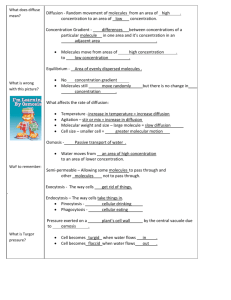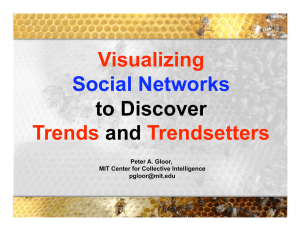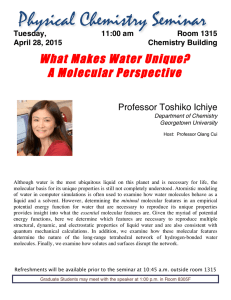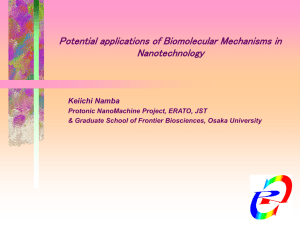1 Technologies capabilities from the last century has been discovered, proposed
advertisement
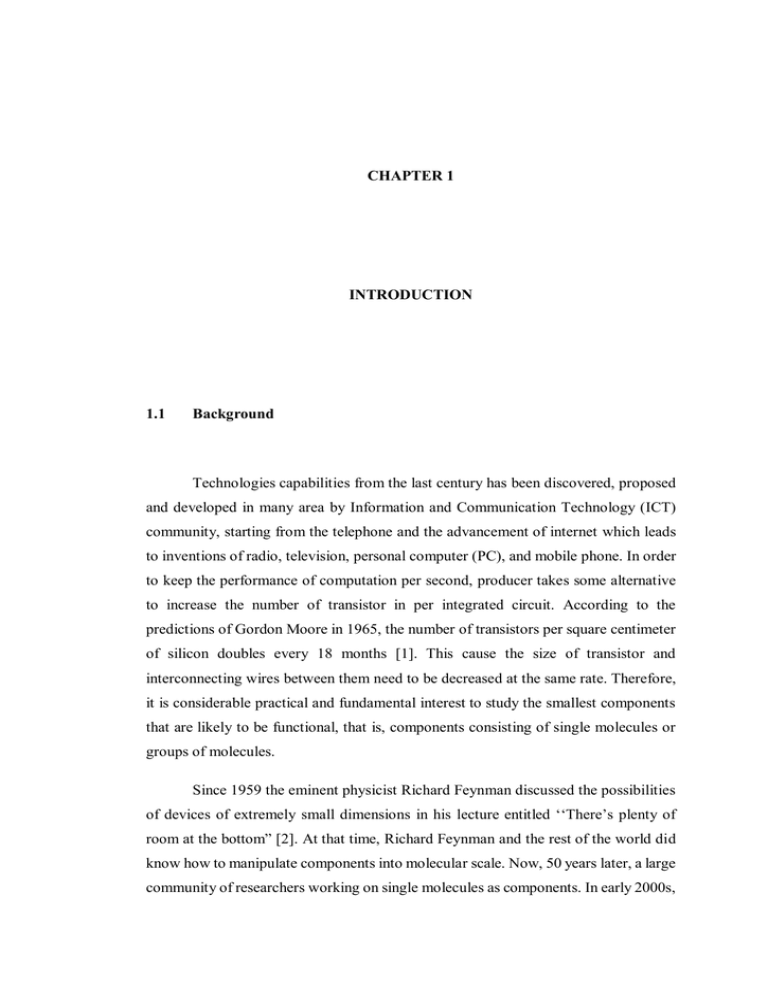
1 CHAPTER 1 INTRODUCTION 1.1 Background Technologies capabilities from the last century has been discovered, proposed and developed in many area by Information and Communication Technology (ICT) community, starting from the telephone and the advancement of internet which leads to inventions of radio, television, personal computer (PC), and mobile phone. In order to keep the performance of computation per second, producer takes some alternative to increase the number of transistor in per integrated circuit. According to the predictions of Gordon Moore in 1965, the number of transistors per square centimeter of silicon doubles every 18 months [1]. This cause the size of transistor and interconnecting wires between them need to be decreased at the same rate. Therefore, it is considerable practical and fundamental interest to study the smallest components that are likely to be functional, that is, components consisting of single molecules or groups of molecules. Since 1959 the eminent physicist Richard Feynman discussed the possibilities of devices of extremely small dimensions in his lecture entitled ‘‘There’s plenty of room at the bottom” [2]. At that time, Richard Feynman and the rest of the world did know how to manipulate components into molecular scale. Now, 50 years later, a large community of researchers working on single molecules as components. In early 2000s, 2 advancements activities of nanotechnology begins to accelerate. Scientists around the world starting to work together and break the barrier among their respective fields to allow novel materials, structures and devices. Nanoelectronics, nanomechanics and nanophothonics are such emerging field of researches that leads to new discoveries such as nanometarilas, nanocrystal, nanotubes and nanomachines which are promise significant changes to many fields of science and engineering. 1.2 Nanotechnology Nanotechnology is one of the growing field of research among other fields today. It has many opportunities to be developed and explored by researchers. Nanotechnology is a field that allows the manipulation of materials and atomic at molecular scale from one to hundred nanometers. This technology will also enable the fabrication of device in nanometer scale. This is a new multidisciplinary field based on knowledge from different scientific areas such physics, chemistry, material science, molecular biology, computer science and engineering. The term Nanotechnology defined by N.Taniguchi, on the basic concept of Nanotechnology as “Nanotechnology mainly consists of the processing of separation, consolidation and deformation of materials by one atoms by one molecules”. In engineering term, nanotechnology can be defined as “engineering at a very small scale”. Nanotechnology will enable very powerful computers but simple devices ranging in some nanometers which is called nanomachine. 3 1.3 Nanonetwork and Nanomachine The devices in this ranging scale nano known as Nanomachines. Nanomachine is expected to perform meaningful tasks at nanoscale including computing, data storage, sensing, actuation and communication. At this scale, a nanomachine known as most basic functional unit. Interconnection between nanomachine is known as nanonetwork for corporation and information sharing among them, to fulfill the complex task. Nanonetwork terms refers to electronics components and their interconnection on a nanoscale [4]. This concept known as Network-On-Chip. In this thesis, term nanonetwork is strictly used based on molecular communication. Nanomachine can be further used as buildings blocks for the development of more complex system such as nanoprocess, nanomemory or nanoclocks [5]. Communications between nanomachines can be distinguished by mechanical, acoustic, electromagnetic and chemical or molecular communication [6]. Nanomechanical communication is defined as transmission of information through mechanical contact between the transmitter and receiver. For acoustic communication, the transmitted message is encoded using acoustic energy such pressure variation. In electromagnetic communication it is based on modulation of electromagnetic waves to transmit information. Molecular communication can be defined as the use of molecules as to pass message between transmitter and receiver. Among mechanical, acoustic, electromagnetic and chemical or molecular communication, Molecular Communication (MC) is most promising paradigm to implement in nanonetwork based on following advantages [7]. Based on principle communication of traditional acoustic, the transducer and radio frequency receiver need a large space to operate. It is impossible for them to integrate at a nanocscale. In comparison with molecular communication, molecular transceivers are natural built in at nanoscale. For nanomolecular communication, the transmitter and receiver need to be in direct contact with each other. This principle is not applicable in nanoscale over 4 the large area, where the transmitter and receiver can be remotely as long as molecule message is reached at the receiver. 1.4 Nanomachine Development Three different strategies in development of nanomachines as can be seen as display in Figure 1.1; which are top down, bottom up, and bio-hybrid. Figure 1.1 Approaches for development of nanomachine [1] The top down approach, is based on the increasing miniaturization of mechanisms and structures to nanoscale. It means, downscaling the present devices at microscale to develop nanoscale machines, involving microelectronics and electroctromechanical device [8]. Recently progress being made known as MicroMechanical System or MEMS, where mechanical components in devices is integrated with electrical circuitry using electron beam lithography. However, this approach still is in early stage. The bottom-up approach is based on exploitation of science and technology from nanoscale, which would be molecules to construct larger structure by using physicals and chemicals sources that operate at nanoscale. This bottom-up approach is 5 called “molecular nanotechnology”. This is a promising way of creating nanomachine precisely. In Bio-hybrid approach, some biological components found in living or organism can be considered as nanomachine (Figure 1.2). There are nanobiosensor, nanoactuators, biological data storing unit and control units which can be found in the cells [8]. These biological structure inspired the possibilities of building nanomachine that performs sensing, production, control and locomotion task to perform more complex systems such as nanorobots. Figure 1.2 Biological Nanomachines [8] 1.5 Applications of Nanotechnology Nanotechnology promises new solutions for application from different fields: Medicine: Nanotechnology will allow the possibility to merge nanomaterials and biological components due to these nano-scale stuff are in the same length scale than cellular inner structures and organelles. This provides a new way to enhance more powerful diagnosis machines, sensors, analytical instruments, physical therapy applications, and drug delivery vehicles. 6 Information and Communication: Nanotechnology will enables the advancement of the capacity of present memory storage devices, an expand of the computing capacity, and the creation of new optoelectronic and semiconductor instruments. Energy: There are also respective research groups that are doing projects concerning on energy conversion, saving, storage, and the creation of powerful renewable energy sources. 1.6 Problem Statement Propagation is the process of information travelling from transmitter to receiver. In diffusion based molecular communication, molecules information will diffuse through medium to reach at receiver. The medium propagation also can be referred as channel which the concept is similar to conventional communication. However the performance of transmission in diffusion communication decreased rapidly as transmitter and receiver distance further away. There are some approaches in order to improve reliability of diffusion communication such as multiple input multiple output, MIMO, multihop deployment scenario and cooperative relay. However these approaches required perfect coordination cause the system become more complex and a large group of nanomachine to be deployed in diffusion communication network, which is not practical in real communication due to limitation size of network which only at nanoscale. In this thesis, the approach used is based on basic diffusion concept of Fick’s law and the basic concept of molecular motion known as Brownian motion. Fick’s law explains that the diffusion rate is based on difference concentration of medium between two regions, while in Brownian motion involves the random motion of molecules in the medium. By applying Fick’s law and Brownian motion concept in diffusion communication network, the characteristics of concentration and velocity of molecules in medium propagation can be studied. So, 7 there is no need of grouping and coordination in diffusion communication network make the system has less complexity and uncomplicated to implement. In addition, this thesis also concern on the effect of different topologies in the network. This is because in the current research work, the analysis of diffusion based molecular communication until today is limited to review of different shapes topology in DMC without any experimental simulation has been conducted yet. 1.7 Objectives and Solutions The focus of this master thesis is study on molecular communication in diffusion based. In other words, the propagation of the information from transmitter to receiver is through diffusion process. The following are objectives of this study: 1. To study the characteristics that influence the propagation process of information molecules from transmitter to receiver. In order to achieve this objective, some variables such as medium concentration and velocity are studied to find the effects toward propagation of information molecules at certain distance. The performance analysis in terms of throughput and Percentage of total loss. 2. To perform the simulation of diffusion based communication in the different shape of topologies and to analyse the performance of DMC in various topologies in terms of throughput and Percentage of total loss. 8 1.8 Scope of Works The focus of this thesis is on Diffusion-based channel in Molecular Network (DMC). DMC uses law of diffusion based, which is passive propagation. Fick’s Law is applied to DMC which means that the molecules are moving according to Brownian motion. Since the diffusion is considered as short range communication, so we calcium signalling model is used for this research work. The characteristics concerned in this thesis are medium initial concentration and velocity. Different shape of network topologies are studied such as star, bus and ring topology. N3Sim simulator will be used in order to simulate a set of nanomachine which communicate among them through molecular diffusion in a fluid medium 1.9 Thesis Outline The rest of the thesis is organised as follows: Chapter 2 introduces molecular communication and it’s difference from conventional communication. The different type of molecular communication based on propagation characteristics and range operation communication, Diffusion based mathematical models, Diffusion based propagation models, and calcium signalling as models are discussed. Chapter 3, describes model of network and method to study the parameters and variables. In Chapter 4, results and analysis from the simulations are based on different values of velocity and medium concentration will be discussed. Chapter 5, a conclusion remark will be made and future work related to this study will be highlighted.
